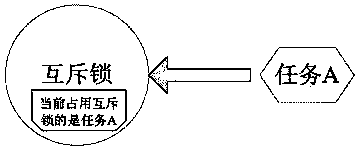Task dispatching method and device based on DSP (digital signal processing)
A task scheduling and task technology, applied in the direction of multi-program device, program startup/switching, etc., can solve problems such as limited use scenarios, priority reversal, lost hardware interrupts, etc., to ensure execution efficiency, ensure real-time performance, and improve real-time effect
- Summary
- Abstract
- Description
- Claims
- Application Information
AI Technical Summary
Problems solved by technology
Method used
Image
Examples
Embodiment 1
[0062] refer to figure 2 , which shows a flow chart of Embodiment 1 of a DSP-based task scheduling method of the present application, which may specifically include:
[0063] Step 201, record the task information occupying the mutex in the data structure of the mutex;
[0064] In a preferred embodiment of the present application, when the P operation of the task on the mutex is successful, the information of the task can be recorded in the data structure of the mutex as the task information occupying the mutex . Since the success of the P operation of the task on the mutex lock can indicate that the mutex is occupied, this preferred embodiment can record the task information occupying the mutex in time. Of course, record the occupation of the mutex in the data structure of the mutex. Other timings for the task information of the mutex are also feasible, for example, within several instruction cycles after the task's P operation on the mutex is successful.
[0065] refer to...
application example 1
[0076] refer to Figure 5 , shows an application example 1 of a DSP-based task scheduling in the present application. In this example 1, there are 3 tasks: A, B, and C. The priorities of the 3 tasks are: A
[0077] At time T0, task A performs P operation on a certain mutex. If the previous state of the mutex was obtainable, it becomes unacquireable now. Task A occupies the mutex. At the same time, the P operation of task A succeeds and Return to continue the execution of task A, and record the information of task A in the data structure of the mutex
[0078] At time T1, interrupt a occurs and triggers task B;
[0079] At time T2, task B preempts the CPU of task A and is running;
[0080] At time T3, interrupt b occurs and triggers task C;
[0081] At T4, task C preempts the CPU of task B and is in the running state. Task C tries to acquire the mutex locked by task A by executing P operation, and is blocked; at this time, r...
example 2
[0087] refer to Figure 6 , shows a method example 2 of a DSP-based task scheduling method of the present application, there are 5 tasks in this example 1: A, B, C, D and E, and the priority ranking of the 5 tasks is: A<B <C<D<E, which may specifically include the following steps:
[0088] At time T0, task A performs P operation on a certain mutex. If the previous state of the mutex was obtainable, it becomes unacquireable now. Task A occupies the mutex. At the same time, the P operation of task A succeeds and Return to continue the execution of task A, and record the information of task A in the data structure of the mutex
[0089] At time T1, interrupt a occurs and triggers task B;
[0090] At time T2, task B preempts the CPU of task A and is running;
[0091] At time T3, interrupt b occurs and triggers task C;
[0092] At time T4, task C preempts the CPU of task B and is in the running state. Task C tries to acquire the mutex occupied by task A by executing P operation,...
PUM
 Login to View More
Login to View More Abstract
Description
Claims
Application Information
 Login to View More
Login to View More - R&D Engineer
- R&D Manager
- IP Professional
- Industry Leading Data Capabilities
- Powerful AI technology
- Patent DNA Extraction
Browse by: Latest US Patents, China's latest patents, Technical Efficacy Thesaurus, Application Domain, Technology Topic, Popular Technical Reports.
© 2024 PatSnap. All rights reserved.Legal|Privacy policy|Modern Slavery Act Transparency Statement|Sitemap|About US| Contact US: help@patsnap.com










